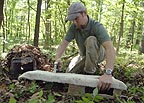May 16, 2007
Special 'logs' hold key to swamp rabbit study

Caption follows story
For a group of wildlife scientists at Southern Illinois University Carbondale, that moment involved finding out if swamp rabbits would use a fake "log" latrine specially designed for them.
There is, of course, serious research associated with this effort, though the relative humor of the situation is not lost on the researchers, scientists and graduate students with the Cooperative Wildlife Research Laboratory at SIUC who are conducting the study. The team is using a four-year federal grant worth more than $200,000 through the Illinois Department of Natural Resources to examine how well programs aimed at reclaiming swamp rabbit habitat are working. The effort involves observations, trapping, DNA studies and computer modeling, all of which will go into a final report to the IDNR in 2009.
The swamp rabbit is a larger, darker-colored and meaner cousin of the more common cottontail rabbit. The swamp rabbit prefers bottomland hardwood forests as habitat and hunters know it as a challenging game animal with meaty haunches. The animals weigh in at 3 to 6 pounds — about twice as big as cottontails — are famously scrappy and don't hesitate to plunge into the water as a means of escape.
As it turns out, finding their droppings left on logs is one of the best ways to study the population of swamp rabbits living in the limited habitat available to them in Illinois.
If the team is successful, its report will say whether federal programs, such as those that pay farmers to leave parts of their lands fallow or return them to wetland status, actually help swamp rabbit numbers recover in Illinois.
"Swamp rabbit numbers have declined due to the loss of habitat when those areas were put into agriculture use over the years," said Clay K. Nielsen, an assistant scientist with the laboratory and a principle investigator on the project. "They are a valued resource for hunters and an important prey species. They are also an important indicator species for the overall well being of a particular habitat.
"The goal is to understand how well the swamp rabbits use agriculture land that has gone back to wilderness," Nielsen said.
The nature of such land, however, does not lend itself to having many mossy, rotting fallen logs, which is where the swamp rabbit prefers to announce its presence by defecating. This turned out to be no problem for the inventive researchers, who quickly came up with a solution.
"If there are no logs, how do tell if you have rabbits?" said Eric M. Schauber, assistant professor of zoology and another principal investigator on the project. "So we thought maybe if we supplied logs, actual logs, that might work. But you know the problem there — way too heavy. Also, the rabbits tend to like the mossy, rotting logs."
Loving a challenge, Schauber set out to create a portable, realistic outhouse for the rabbits. He designed a four-sided, collapsible wooden box with unsupported carpeting across its top to simulate the height and all-important feel of the natural log latrines for the rabbits. Graduate students working long hours in the lab's workshop turned out 400 of the contraptions, which team members placed at about 30 sites on or near the Cypress Creek National Wildlife Refuge last fall.
In November, graduate students brought back pictures of fresh rabbit droppings on the artificial logs. "It was a wonderful sight," Schauber said. "We knew then that it worked."
Having control over the placement of such "logs" also opened other aspects of research for the team, Schauber said. They could, for instance, examine whether the number and placement of logs affected population, among many other possible variables.
During the winter, graduate student Paul Scharine, of Appleton, Wis., placed the logs and some live traps nearby to verify the authenticity and make a population count. For four months, he daily walked and motored miles though the wilderness to check droppings and traps, catching and releasing 28 swamp rabbits during that time.
He also witnessed the animal's ferocity up close.
"I saw a lot of torn ears where they apparently get into fights with each other," Scharine said.
Scharine also collected many samples of droppings, which doctoral student Leah K. Berkman, of Chicago, will analyze for DNA along with Charlotte Roy Nielsen, a researcher at the lab and the third principal investigator on the project. Another graduate student, Lyann Rubert, of Miami, is using the data collected to model potential habitats and interconnecting corridors that will encourage swamp rabbit numbers in the area.
Clay Nielsen said he looks forward to the final report.
"It's a novel research effort, certainly using novel tools," he said.
Be very quiet – Paul Scharine, a graduate student from Appleton, Wis. sets up an “artificial latrine log” invented by researchers at Southern Illinois University Carbondale’s Cooperative Wildlife Research Laboratory to study the habits of swamp rabbits. Scharine is part of a team of wildlife researchers using a four-year federal grant worth more than $200,000 through the Illinois Department of Natural Resources to examine how well programs aimed at reclaiming swamp rabbit habitat are working. The effort involves observations, trapping, DNA studies and computer modeling, all of which will go into a final report to the IDNR in 2009. On the left sits a trap Scharine used to trap swamp rabbits as a means of verifying their numbers in conjunction with the “logs.”
Photo by Russell Bailey
